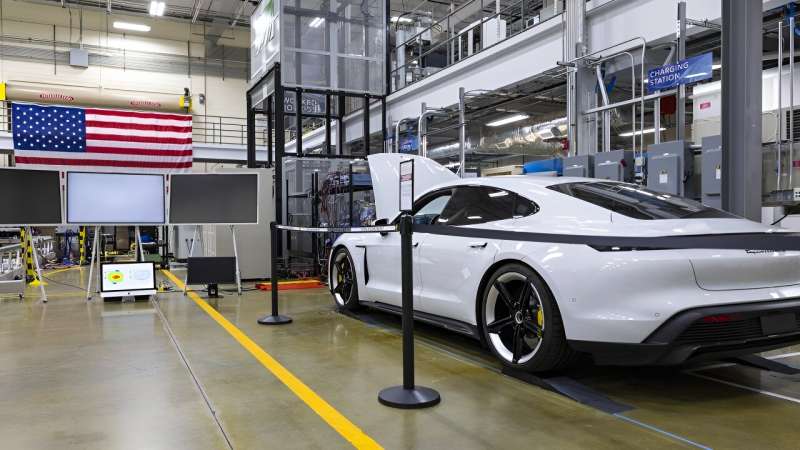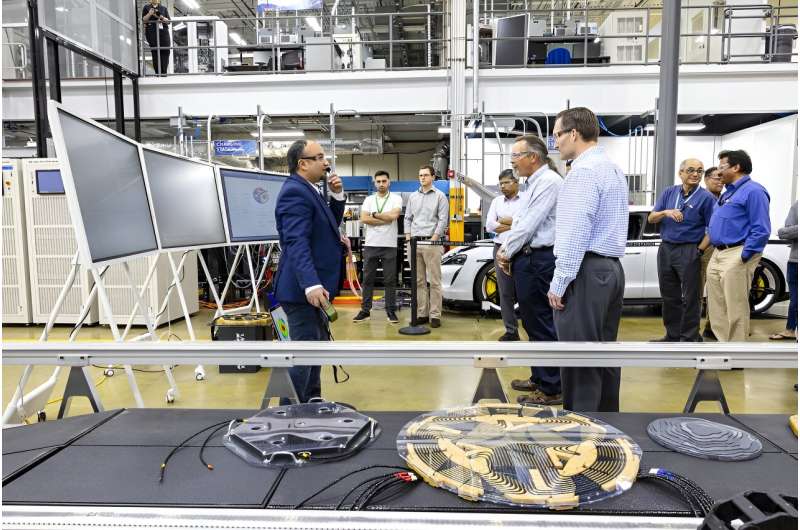This article has been reviewed according to Science X's editorial process and policies. Editors have highlighted the following attributes while ensuring the content's credibility:
fact-checked
trusted source
proofread
Polyphase wireless power transfer system achieves 270-kilowatt charge in electric vehicle

Researchers at the Department of Energy's Oak Ridge National Laboratory have successfully demonstrated the first 270-kW wireless power transfer to a light-duty electric vehicle. The demonstration used a Porsche Taycan and was conducted in collaboration with Volkswagen Group of America using the ORNL-developed polyphase wireless charging system.
The achievement surpasses ORNL's recent 100-kW wireless charging demonstration and is another breakthrough for fast wireless charging.
"In the past three months, the ORNL vehicle power electronics and electric drives research teams have set impressive world records for wireless charging," said Lee Slezak, DOE's Vehicle Technologies Office technology manager for grid and charging infrastructures. "These achievements will further speed up the adoption of electric vehicles in the U.S."
As a light-duty passenger vehicle, the Porsche Taycan would be difficult to equip using conventional large, heavy wireless power transfer systems. The vehicle can't support the charging hardware due to space, weight and volume limitations. Existing wireless charging systems for light-duty vehicles are currently under development for up to 11-kW power levels with up to 92% efficiency. Current industry standards cover up to 20-kW power levels.
The ORNL-invented system that transferred power to the Porsche uses lightweight polyphase electromagnetic coupling coils with a diameter just over 19 inches that allow for higher power density in the smallest coil possible. This process is similar to the wireless charging of small consumer devices, but the unique geometry and design of the polyphase coils enable the transfer of extremely high power levels using rotating magnetic fields generated by the coil phase windings to boost the power. The charging system was seamlessly integrated into the undercarriage of the vehicle.
The wireless power transfer technology also includes protection systems that prevent exceeding voltage and current limits, overheating and short-circuiting. These systems can initiate shutdown procedures in the event of power interruptions or other unexpected conditions that would interfere with safe power transfer.
"The receiver coil designed for the Porsche Taycan research vehicle can achieve 8 to 10 times higher power density compared to existing systems," said ORNL's Omer Onar, leader of the Vehicle Power Electronics group and lead researcher on the Porsche demonstration. "Per kilowatt weight, this is also the most lightweight charging system in the world."
Power density is important in wireless charging because it indicates how much power the system can handle relative to its size. The goal is to achieve higher densities from smaller, more compact systems to improve overall efficiency and performance. ORNL's system can achieve a 50% increase in state of charge within 10 minutes with more than 95% efficiency. The power transfer was conducted over a 4.75-inch gap between the ground and the coil mounted to the underside of the vehicle.
The 270-kW demonstration marks the completion of a project that ORNL and Volkswagen announced in 2021. ORNL's research team leveraged Volkswagen's expertise in vehicle integration to test the new wireless charging concept on an electric vehicle with the goal of developing the highest-power density wireless charging system through a new design that focuses on rotating electromagnetic fields. These fields increase efficiency by reducing voltage and eliminating electric current ripples and field cancellations between the coil phase windings.
"It's exciting to see the significant progress Volkswagen and Oak Ridge National Lab are making together in many critical technologies. Innovation projects being researched in East Tennessee will transform the automotive industry," said Lyndon Lie, Volkswagen Group of America's chief engineering officer. "Wireless charging like that demonstrated with Oak Ridge could make charging EVs significantly easier for consumers, with quick charging times encouraging zero emissions adoption and leading to a more sustainable transportation sector."
Onar said ORNL and Volkswagen plan to continue working together in the near term to further improve upon the 270-kW charging prototype by developing it into a more cost-effective and manufacturable system.
"We're also working with Volkswagen on developing a polyphase system for residential charging applications and collaborating on the development of a lightweight enclosure design that will improve mechanical, electrical, thermal and magnetic performance," Onar said. "Our goal is to mature the technology so that it's ready for deployment in production vehicles."

ORNL researchers have been demonstrating technology improvements in wireless charging for the past decade, achieving 20-kilowatts transferred to a sports utility vehicle in 2016 with a charging system that utilized an ORNL-built inverter and coupling technologies. In 2018, the research team achieved a 120-kW charge using conventional coil technology in benchtop lab testing.
The 100- and 270-kW demonstrations mark the first time ORNL's polyphase system has been tested on electric vehicles.
"We're working to reach much higher charge rates for other types of vehicles, including investigating achieving a significantly higher charge for heavy-duty freight and transport trucks," Onar said.
ORNL's efforts to pursue higher charge rates will encourage electric vehicle use by increasing range and ease of charging, which is particularly needed for daily commuter, light-duty passenger vehicles.
"This achievement gets us one step further to the reality of a future where an electric vehicle can pull into a charging station and recharge in the same time it would take to walk into a store and grab a snack," said ORNL's Burak Ozpineci, corporate fellow and distinguished researcher who leads vehicle and mobility systems research. "The driver doesn't have to do anything but park. We're even exploring ways that this technology could be used to charge a vehicle in motion on the roadway."
ORNL's novel polyphase electromagnetic wireless system was built and developed by researchers in the Power Electronics and Electric Machinery Laboratory at DOE's National Transportation Research Center at ORNL. The electric vehicle demonstrations were conducted in the Grid Research Integration and Deployment Center at ORNL. These demonstrations advance DOE's extreme fast-charging goal to develop a system that delivers 250 to 300 kilowatts to electric vehicles and reduces charging time to 15 minutes or less.

















